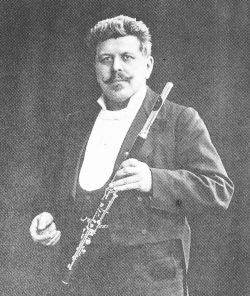

Maximilian Schwedler (1853–1940) was principal flutist of the Leipzig Gewandhaus Orchestra from 1881 to 1917, and an instructor at the Leipzig Conservatory for 35 years. He felt that the simple system flute with its conical bore was more expressive than the Boehm flute, but that it could be improved. He and his collaborators designed and patented a number of flutes, including the Reform Flöte in 1898. He is seen holding his reform flute in the photo above.
Much of the information about Schwedler and his flutes on this page is taken from the thesis of John Bailey mentioned in the references. I want to acknowledge this important resource right away.
The 1885 model Schwedler & Kruspe flute was developed with F. W. Kruspe of the Erfurt firm of C. Kruspe. Schwedler may have interacted at that time with the young Carl (or Karl) Kruspe Jr. (1865–1929), who established a firm under his own name in Liepzig in 1893 and became Schwedler's collaborator on the 1895 model Schwedler & Kruspe flute and the 1898 reform flute.

The 1885 and 1895 models are not yet reform flutes. These Schwedler flutes are discussed separately on this site. To review, the 1885 model was a simple system flute, with the characteristic six unencumbered finger holes—and closed-standing keys on the body for production of the semitones outside of D major, and for trills. It had a number of distinctive features, including the Schwedler embouchure (in German, Schwedler-Mundloch) with raised 'cusps' on either side of the embouchure hole, which were continued on all later Schwedler-Kruspe models. The 1895 model had the C-C# brille (an assembly involving an extra hole/pad and two ring-keys) and so was not strictly speaking a simple system flute. These flutes may look complex—because of Schwedler's extra trill keys—but these models are not true reform flutes, and the use of the term reform flute to describe them should be avoided.

The instrument introduced in 1898 was called the Reform Flöte "System Schwedler-Kruspe" (Modell 1898). The term Reformflöte belongs to Schwedler and Kruspe; other makers produced flutes modeled after it but did not use that name. Nevertheless, we may use 'reform flute' to include any flutes that have the 'reform' and other features of the 1898 model (see below).


Many models of reform flutes were eventually manufactured, by Kruspe and others. Schwedler and Kruspe introduced new models in 1901 and 1912. Schwedler's collaboration with Kruspe ended circa 1921, and Schwedler arranged to have the Moritz Max Mönnig firm of Leipzig build his reform flutes. Many variations were available.
Reform flutes have some or all of the six finger holes of the simple system flute equipped with ring keys or covered by key cups with pads. This is not what makes them reform flutes as the term was used by Schwedler, but it often helps us quickly distinguish reform flutes from other German flutes. Once these six holes that produce most of the D major scale are tampered with, 'simple system' no longer applies, according to my usage of the term. The flutes in the photo below are reform flutes.
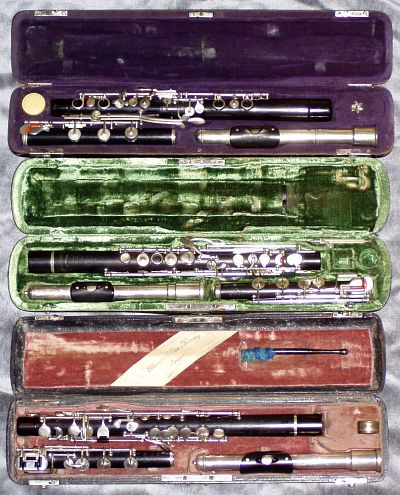
Schwedler had some 'modern' ideas. He wanted the flute to be louder in the low notes. He advocated a regular use of vibrato. Schwedler believed in the use of one fingering for each note. He did give alternate fingerings for special purposes, but thought the flute should be designed and optimized to give the best intonation (equal temperament), tone, and response for one fingering, and not compromised—in the way, for example, some simple system flutes compromise the tuning of the F#, leaving it flat, in order to allow the forked F fingering to give an acceptable F.
But Schwedler resisted other modern trends. It was essential to him that the character of the old flute be preserved. He did not like the way the Boehm flute could be heard ringing out above the orchestra, so to speak, but believed that the flute should be darker in timbre and should blend into the wind ensemble sound. In addition, he hoped to preserve the basic simple system fingering, in so far as possible.
The patents for the Schwedler-Kruspe system flutes include many features and design details, e.g. various vent holes, that we will not discuss here. We will talk about and illustrate what we think are the most significant or important features of reform flutes, over and above the six important features enumerated earlier for the 1885 model Schwedler-Kruspe flute.
|
The photos below show reform flutes by Gottlob Hermann Hüller (Schöneck, early 20C) and Schwedler & Kruspe (Leipzig, after 1912). The first is similar to the original 1898 model reform flute. It has features 1 through 9 from the above list. The C/C# brille of the 1895 model Schwedler flute is still present on the 1898 model. (One might consider the C/C# brille as a feature of reform flutes in general, but we did not include it in the list of features because the characteristic appearance was lost when the idea was incorporated into the mechanism of the later models.) A flute with all 11 features will be called a '1912 model' in the sequel. The second flute, from the Carl Kruspe firm of Leipzig, is an example of the 1912 model reform flute.
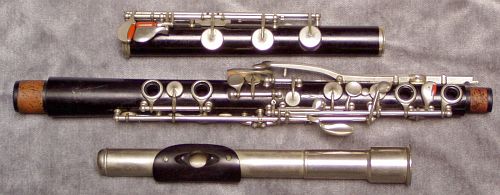
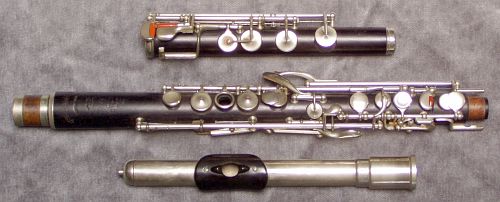
1912 model reform flute by Schwedler & Kruspe
The metal headjoint of the reform flute was equipped with an ebonite lip plate and the Schwedler embouchure. We reiterate that a metal head or Schwedler embouchure does not mean that a flute is a reform flute or even a Schwedler flute! Once this type of head/embouchure became popular, it was used on flutes ranging from simple system to Boehm system.

On the 1912 model Schwedler-Kruspe flute seen above, the A and E holes are not directly beneath their fingers (LH3 and RH3), but are moved slightly down the tube and governed by open standing keys with touches under LH3 and RH3. This is the same idea as introduced on the Siccama diatonic flute many years earlier, although the displacement seems less drastic than Siccama's.
A different instance of hole displacement may be seen on the flute by Hüller. The holes for A and G are closer to the center of the flute, and are governed by open standing keys.
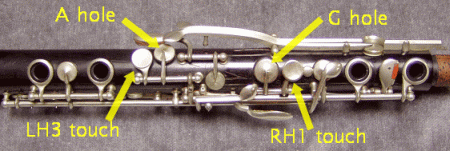
Once open-standing keys were provided for some holes, those holes could be and sometimes were made larger. But the holes on a reform flutes are not uniform in size.
Feature 9 is important in that it is the REFORM in 'reform flute'. Players of the simple system flute with four or more keys have always been advised to keep an F key (long or short) open as often as possible, but primarily when playing the F#'s in the first two octaves. This helps to sharpen the F#, which has a strong tendency to be flat. Schwedler believed that the F key should be opened to aid the venting of 18 or 20 separate notes including F# through B in the first two octaves, though the effect seems negligible for most of them. The effort required to keep an F key open complicates technique in many cases, and it is a great relief to need to use the F key only for the two notes f' and f''. This convenience was thought by Schwedler and others to be very significant, and worthy of the name `reform'.
The Schwedler-Kruspe and the Mönnig 1912 models have two holes for F, one kept closed by a short F key, and the other with an open-standing cup and pad. This second F hole remained open unless RH2 or RH3 was on its key. Its key cup can be seen under the flute in the photo after the next, The Hüller flute implements the extra venting less completely, but it does have automatic extra venting for F# and G. At rest, there are three holes open on the right-hand side of the body. But when LH3 is down, a fourth hole on top of the body is opened. This extra hole is open when F# is played with RH1 but is closed by the ring keys for RH2 or RH3.
The D-mechanism can be seen below, on the Schwedler-Kruspe flute. It has two opposing springs. The 'extra D hole' is almost always closed (kept closed by a strong spring on the body, via a clutch). It is raised (by a weak spring on the foot) only when RH3 depresses its key and pushes the clutch out of the way. Most significantly, this sharpens the d' and d'', which notes tend to be flat, and sometimes very flat, on 19th century simple system flutes. It would have a lesser effect on e'flat and e''flat. Both the extra and the original D holes are closed by the C# key.

It is worth noting that the problem of flat d' and d'' was solved by this complicated device, and not by simply increasing the size of the D hole or moving it upward, or a bore change. Those changes would presumably harm various notes in the third octave and/or otherwise throw the system off balance.
Reform flutes with the F-mechanism have two F holes, one closed by the short F key, and the other with an open-standing key closed by RH2. There is, as a rule, no long F key, it being found unnecessary with the F-mechanism. RH1 closed the G hole directly beneath its key, producing F#. When RH1 is extended to depress the lever as well as the key, the lever closes the F# hole and F is produced.
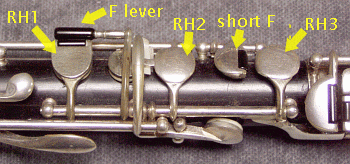
The idea of enabling RH1 to produce either F or F# is not new to Schwedler and Kruspe, but had been implemented earlier, by a different arrangement, on the Carte 1867 model flute.
One of the features sometimes added to the reform flute by Moritz Max Mönnig was an extra long metal headjoint, the 'full tone head' (not shown here). The low B key of their flutes was given to RH4, and some flutes have the distinctive key arrangement for RH4 shown below.
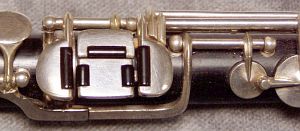
One feature that reform flutes never have is the so-called Reformmundloch introduced in 1904 by Otto Mönnig (not M. M. Mönnig) primarily for Boehm flutes. The blowing wall of the embouchure hole was raised. This is essentially the same as the modern 'wing embouchure'. It is unfortunate and confusing that Otto Mönnig used the term 'reform embouchure'. Schwedler condemned it. It is not Schwedler's embouchure and has nothing to do with reform flutes.
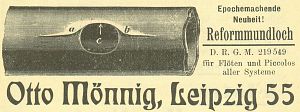
The reform flute was for a time very commonly found in German orchestras, but its popularity waned in the 1920s. The last player of the reform flute in a major orchestra (Dusseldorf) retired circa 1940, according to Bailey, though I understand that these instruments could still be heard, played by flutists who may have studied with Schwedler, after 1960. The causes of the reform flute's decline in popularity are varied. But it was not the sound—the sound of the reform flute can be quite wonderful, full but mellow. And it was not the volume—some players of the reform flute were said to be quite loud. It is true that reform flutes tend to have more trouble with the extremely high notes in the vicinity of c'''' than Boehm flutes, and this is perhaps one reason for their wane.
An indirect reason for the decline of the reform flute is the complexity of the system. The 1912 model reform flutes shown above have 21 holes bored in the body and foot, compared to 14 for an open-G#, B-foot Boehm flute. The complicated system of extra holes for venting was contrived to achieve what came naturally to the open-key system of the Boehm flute. But Schwedler did manage to preserve with his complicated system, for a few decades at least, an old and valued sound, one that is not the same as a conical Boehm flute and certainly different from that of the cylindrical Boehm flute.
